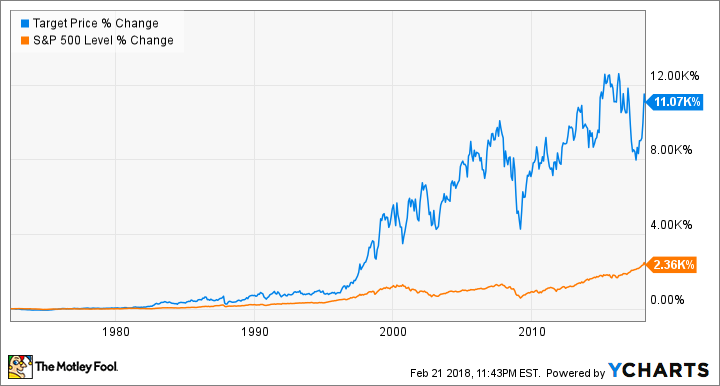Many income investors love Dividend Aristocrats, the elite group of companies that have raised their dividends annually for over 25 years. That's a tough streak to maintain through recessions and market downturns, and generally indicates that a company's business is built to last.
Some growth-oriented investors might think that Dividend Aristocrats are dull, slow-growth stocks. Over the long term, however, many of these stocks generated multi-bagger returns. Let's take a closer look at two examples -- Target (TGT -0.71%) and AT&T (T -1.21%) -- and how they turned $1,000 investments into small fortunes.

Image source: Getty Images.
Target
Target, then known as Dayton Corporation, went public in 1967 at $34 per share. At the time $1,000 ($7,355 in 2018 dollars) would have been enough to buy 29 shares. After six subsequent stock splits, you would now own 2,784 shares, which would be worth about $203,000 today.
Target would also be paying you over $6,900 in dividends per year. The company has raised its dividend annually for 50 straight years, and it currently pays a forward yield of 3.4%. Over the past 12 months, it spent just 50% of its earnings and 29% of its free cash flow on its dividends -- so it has plenty of room for future hikes.
Sticking with Target over the past five decades required lots of patience and nerves of steel. The company went through several transformations, including its initial expansion of Target as Dayton's biggest retail chain, the introduction of SuperTarget stores to merge discount items and groceries, its divestments of Marshalls and Mervyn's, a failed expansion into Canada, and the launch of its smaller CityTarget stores to address urban markets.
But if you had held Target through the peaks and troughs, you would have fared much better than investors who sold the stock. You would have also easily outperformed the S&P 500, which was founded a decade before Target's IPO.

Chart source: YCharts.
AT&T
The original AT&T was split into smaller regional companies by antitrust regulators in 1983. One of the "Baby Bells," Southwestern Bell (SBC), made its public debut in 1984 at $1.25 per share.
Just $1,000 ($2,354 in 2018 dollars) would have been enough to buy 800 shares of SBC. After three stock splits, you would have accumulated 9,600 shares by 2005. That's the year SBC bought the "new" AT&T -- which housed the remaining parts of the old AT&T -- for about $16 billion, and assumed its former parent company's brand and stock ticker.
This means that you would now own 9,600 shares of the "even newer" AT&T, which would be worth nearly $350,000 today. Your investment would also be generating over $19,000 in dividends every year.
AT&T raised its dividend annually for over three decades, and currently pays a forward yield of 5.4%. It spent 41% of its earnings and 68% of its free cash flow on dividends over the past 12 months. However, AT&T hasn't outperformed the S&P 500 after its reverse merger with SBC closed in Nov. 2005.

Chart source: YCharts.
But mind the total return...
For the sake of clarity, these examples assume that investors didn't reinvest their dividends. However, it's usually a good idea for long-term investors to sign up for a DRIP (dividend reinvestment plan) to automatically reinvest their dividends without additional brokerage fees.
This lets investors accumulate more shares when the price is low, and fewer shares when the price is high. It smooths out the average purchase price over time, and generates compound returns as additional shares boost dividend payments.
To gauge that impact, we should compare a stock's total return (which assumes that the dividends are reinvested) with its price appreciation. Here's how much difference reinvested dividends would have made over the past decade for Target investors:

Chart source: YCharts.
The difference is even more dramatic for AT&T investors, who might be unimpressed with the stock's price performance after the SBC merger.

Chart source: YCharts.
The bottom line
Many Dividend Aristocrats are great investments, but only if you hold them through thick and thin while reinvesting the dividends. Keep that in mind the next time the market drops or analysts start panicking about rising interest rates wiping out dividend stocks.



